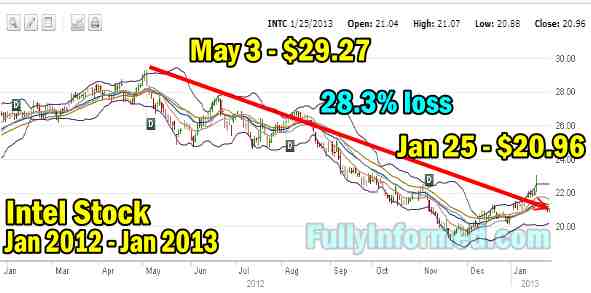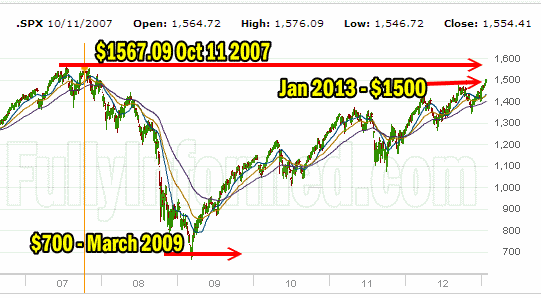The market direction climb to reach 1500 has seemed almost relentless throughout January. On Friday the S&P 500 closed above 1500 marking an amazing recovery from the depths of the bear market of 2008 to 2009 and more than doubling the value of the S&P 500 from 700 to 1500. With the market pushed to 1500, are stocks overvalued? Is this a time to commit more capital or less capital? Should investors be buying now or should they wait for a correction and what happens if that correction is so small that stock valuations are hardly impacted at all or so severe that investors panic and begin to dump shares?
Market Direction and Strategy Work Together
I have repeated many times before that market direction and investing strategy work together. As market direction has continued to push higher, the VIX Index has pulled back reaching levels not seen since 2007. (read this article on VIX Index importance) As the market direction has climbed many investors are wondering about when the inevitable correction will occur and how big a correction to expect. My market direction technical indicators have pointed out the extreme overbought condition of the market direction up for days now and still I remain invested. It is strategy that allows me to not be concerned one way or the other with market direction.
The key to profits is knowing which strategies perform best under what market direction, up, down or sideways.
If the market direction continues higher then I turn to strategies that will provide profit and more protection to the downside. If the market direction stalls and turns sideways then a different strategy must be called upon to profit from the stalled market direction. If a correction commences and turns nasty, still other strategies can be used to earn profits when market direction is tumbling.
It is strategy that holds the real value in profiting from market direction moves and through the knowledge of which strategy to apply when or in what market environment an investor can set aside emotion and profit and protect at the same time.
Even after 35 years of investing, I continue to paper trade strategies to determine which strategies perform best in which conditions. It is experience that teaches which strategies to apply in what market environment. Using market direction technical indicators helps me in understanding market trends and aids in picking the strategy to use for the market direction before me. Paper trading various strategies to see those that perform best in different market directions is what gives experience to draw upon to profit in any market direction.
Market Direction and Put Selling
My principal investment method is Put Selling against large cap dividend paying stocks. This strategy never gets old and never fails to provide profits. But I have a distinct advantage, I only do put selling against stocks I would own and because of this I can continue to keep my capital working as the market direction pushes higher or lower.
When the correction does come and it will, I am able to continue to roll puts forward if they fall into the money, to avoid being assigned while I still earn additional capital on the rolling strategy. I then continue Put Selling at lower strikes if a correction is more severe than expected, which at present I am doubtful of.
A good example would be my Intel Stock puts. Half of the Intel Stock puts are in the money and at risk of assignment at valuations far above where Intel Stock is trading. (review Intel Stock 2012 trades here).
But by rolling in the money puts, reducing the number of put contracts during the rolling process and continuing to put sell at lower strikes, I am in effect averaging down in a stock, but unlike the usual averaging down through stock purchases, I am earning a profit as I continue to work my way lower in a stock.

Even with market direction pushing higher, stocks can get caught in their own bear markets.
Market Direction, Strategy and The Media
When you consider the huge profits strategy has provided for my portfolio and you consider that the media in general has been negative since the bear market of 2008 to 2009 surely investors must see that following market direction pundits rather than the market direction itself is the wiser thing to do. It is worthwhile to learn strategies to benefit from any market direction and then turn down the noise of the media and focus on the singular goal of growing a portfolio through staying with consistently winning strategies that can grow a portfolio.
Market Direction From 1500 on the S&P 500
While it is true that many individual stocks have not recovered from the market collapse of 2008 to 2009 and indeed I know of some individual stocks that still have never recovered from the 2000 to 2003 bear market, the most important outlook for investors is to realize that market direction is the single most important aspect for investing. Through understanding the market direction trend, an investor can select appropriate strategies for profit and protection.
By establishing the strategies that provide profit and income in any market environment you can safely and consistently grow a portfolio even if that market environment appears to be reaching overvalued prices.
As an investor it is difficult to know what are overvalued prices. It comes down to what you believe is “too much” to pay for an equity. It is no different from buying a quality shirt at a department store. When times are good that shirt is not on sale or if it is, the mark down might be 10%. When times are tougher, that quality shirt is marked down from 25% up to 50% depending on how severe the recession is. Stocks are exactly the same.
Right now the market direction is clearly up and while I cannot judge whether the S&P has another 5%, 10% or even more on the upside over the next while, I do know that I can still do Put Selling on my favorite stocks despite the higher valuations. The key is to remain cautious and not commit all my capital.
Market Direction and Holding Capital Back
By keeping capital back I can easily rescue any trade caught in a downdraft and I can boost my capital in any correction. With the goal of an annual 12% return I don’t need to worry about how much each trade is bringing in as long as each trade is adding profit to the overall portfolio. Instead I know that when a correction comes, and it will, I will make up for poorer returns I am experiencing now during this period when the market is climbing and volatility is falling.
It is knowing when to commit more capital that provides my annual 12% gain.
Market Direction and the January Effect – But Then There’s February
This is after all just January and it has a history of over exuberance from investors. February on the other hand is among the poorer months when it comes to the best 6 months of the year. In general when January has been strong February starts strong and finishes weak. Not steep drops mind you, but weak. This often sets up March and sometimes April for better gains. This often has meant that selling puts in February near at the money strikes is of value as those stocks that pull back in February move higher in March and April and leave my near at the money puts out of the money and expired.
It’s important then, to understand that seasonality also plays a role in the stock market direction and use of strategies and as such it never pays to commit all capital in a run-up only to watch better opportunities appear in following months.
The Next Market Direction Correction
The next market direction correction will push volatility higher and increase put premiums. Put Selling for better premiums depends on volatility and the more severe the correction the better the returns. So I am content to be Put Selling smaller quantities on dips in my favorite stocks, earn the returns I can now, knowing that I can rescue any trade, I have capital set aside to earn bigger profits in a correction no matter the size and my portfolio continues to grow as it should.
Market Direction and the Value Of Strategy Summary
The recovery of the S&P 500 from a low of $700 in March 2009 is truly amazing considering the difficult and unusual economic conditions faced by much of the global community. As well when the 2000 to 2003 bear market is taken into account this marks the second time in 12 years that the S&P 500 has recovered from a severe bear market. Taken into context then, the recovery in 5 years is even more remarkable.

The recovery in the market direction from the low of $700 in March 2009 is an incredible feat.
With the S&P 500 now standing at 1500, a feat not expected by the majority of market analysts and pundits I have read in the past 5 years, it has taught investors an incredible lesson. There is true value in not listening to the endless chatter of the media, doomsayers and pundits who have kept millions of investors out of stocks during what has been a most spectacular recovery. Since the collapse of stocks in 2008 to 2009, the recovery has resulted in profits that can often take a lifetime to achieve.
If the recovery in the S&P 500 has taught investors anything it is that great profits can be accomplished in any market conditions through the use of solid strategies that bring in profits as the market direction goes up, down or sideways.
Review Prior Years Portfolios
View USA Stock Portfolio 2013 Index
View USA Stock Portfolio 2012 Index – Return 40.1%
View USA Stock Portfolio 2011 Index – Return 26.8%
View USA Stock Portfolio 2010 Index – Return 29.86%
View USA Stock Portfolio 2009 Index – Return 113.53%
View Canada Stock Portfolio 2009 Index – Return 61.87%
View Retirement Portfolio 2009 Index – Return 65.77
Internal Market Direction Links
Understanding Short-Term Signals
Market Direction Candlestick Daily View (Members only)
Market Direction Portfolio Ongoing Trades (Members only)
